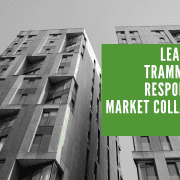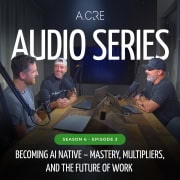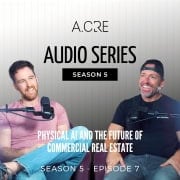The Hidden Gem of CRE Finance: Ina Montejo on Why More Developers Are Turning to CPACE
Welcome to another episode of the A.CRE Consulting Podcast! In this episode, we dive into an innovative financing tool that’s transforming commercial real estate—C-PACE (Commercial Property Assessed Clean Energy) financing. Our guest, Ina Montejo, Assistant Vice President of Originations at PACE Loan Group, brings her expertise to the table to break down how this long-term, non-recourse financing solution is helping developers and investors secure capital for energy-efficient and resilient building improvements. With a background in loan origination, underwriting, and commercial real estate, Ina provides valuable insights into how C-PACE works, who qualifies, and why it’s becoming an essential part of the capital stack in today’s market.
In this conversation, we explore the advantages of C-PACE, including its ability to lower a project’s blended cost of capital, provide retroactive financing, and even replace mezzanine debt in certain deals. Ina also shares real-world examples of how developers are using C-PACE to make their projects financially feasible, even in challenging market conditions. Whether you’re a developer looking to unlock new financing options or an investor seeking alternative funding strategies, this episode is packed with valuable takeaways. Tune in to learn how C-PACE financing could help your next project succeed!
Michael and Ina talk about Why More Developers Are Turning to CPACE
Or Listen to this Episode
Resources from this Episode
- A.CRE Consulting
- PACE Loan Group Website: https://paceloangroup.com/
- Connect with Ina Montejo
Episode Transcript
Ina Montejo – AVP of Originations, PACE Loan Group
[00:00:11]
Michael Belasco:
Welcome to another episode of the A.CRE Consulting podcast. And today I have a special guest with us, Ina Montejo, who is, um, an expert and works in, uh, the CPACE space, which is a special financing option that we’re going to get into in more detail. First, I’ll do a An intro of Ina, I’ll kick it over to her and then we’ll, we’ll get into the conversation.
[00:00:35]
Michael Belasco:
So Ina joined PACE Loan Group in 2023 and is an Assistant Vice President of Originations, where she is responsible for loan origination, loan underwriting, and closing. Prior to joining PLG, Ina held a similar position for Twain Financial Partners, as well as various positions in commercial real estate at MG Properties and Swift Real Estate Partners.
[00:00:59]
Michael Belasco:
She served,
[00:01:00]
she serves as the chair for crew San Diego’s emerging leaders, and is also a member of ULI San Diego and NAOP San Diego in a graduated magna cum laude with the bachelors of business administration in marketing and real estate from the university of San Diego. Lots of San Diego there. So thank you for joining us, Ina.
[00:01:23]
Michael Belasco:
Uh, it’s, it’s a pleasure to have you. You know, we connected prior, but, uh, anything else you want to add before we, we dive into this fascinating space of C PACE?
[00:01:33]
Ina Montejo:
No, I feel like you covered all the bases. Lots of San Diego definitely didn’t realize there is that many San Diego notable mentions on the bio.
[00:01:43]
Michael Belasco:
So why don’t we, um, for our audience, get into the details of C PACE. I didn’t even know about C PACE. So actually, let me give a brief background. So. We came across you and your company. Um, it must’ve been some conversation I
[00:02:00]
had where the project that I’m working on was potentially eligible for this awesome financing opportunity.
[00:02:06]
Michael Belasco:
I think we, I, I may have even just searched around the internet and somehow connect, I forget exactly how we connected. As well.
[00:02:15]
Ina Montejo:
I want to say it, you had just reached out, wanted to gain more information on what CPACE was and if it would be viable for. Project, the RV Park project.
[00:02:27]
Michael Belasco:
Yeah. Yeah. But, um, anyway, nonetheless, it’s fascinating.
[00:02:30]
Michael Belasco:
It, it didn’t work today, but still could work for our project, but I think it’s an awesome program that you guys are involved with and what your company does. So why don’t we give, uh, you know, now we have context into how we, we got acquainted. Why don’t I kick it over to you and you give us sort of a primer on C PACE and what it is.
[00:02:49]
Ina Montejo:
Yeah, , definitely. So C PACE actually an acronym. So it stands for Commercial Property Assessed Clean Energy. So it’s a type of
[00:03:00]
specialty financing. That’s long term, non recourse fixed rate type of financing that’s attached to energy related improvements and renewable energy and, um, weather resiliency type of improvement That are attached to the project, so kind of.
[00:03:21]
Ina Montejo:
I know that was a lot of late words, but think of heavy capex. So mechanical, electrical, plumbing, HVAC, roofing, solar, those would all be examples, PACE eligible items that we would be able to provide funding for. So there’s kind of nuances to the PACE guidelines, eight by three. But generally speaking, we can go up to 35 percent of the project’s asked stabilized value.
[00:03:52]
Ina Montejo:
So um, we’re really only a portion of the total debt stack. So typically when we come in, there’s a senior lender
[00:04:00]
partner alongside us.
[00:04:01]
Michael Belasco:
Yeah. So what makes it so attractive? Let’s talk like rates. Um, I first you said non recourse, which, which is great fixed rate, another, another great thing. Well, what are, what are some other.
[00:04:13]
Michael Belasco:
Attractive incentives, like the rates typically, where do they fall in line in terms of, you know, the traditional financing options?
[00:04:19]
Ina Montejo:
Yeah, so currently we’re typically starting pricing at about 375 ish to about the 10 year. And so that’s fixed that closing. And again, it’s kind of deal by deal. So we’ll, we have some flexibility on the spread.
[00:04:36]
Ina Montejo:
And so typically the point in, and then the pre pace really all 10 feet by face again.
[00:04:43]
Michael Belasco:
Yeah, that’s so, so, okay. So, and then the term you said, how long is the term? Is it 10 years and it’s fixed? And is it, I could be remembering this wrong, but is it, isn’t there some opportunity? I could be totally wrong about this.
[00:04:57]
Michael Belasco:
Is there some opportunity where it’s, it’s
[00:05:00]
like forgivable or, uh, am I making that up?
[00:05:03]
Ina Montejo:
Yeah. So basically with the term, it depends on the. Some states, it’s a 20 year term, some states say it’s 25, some states, like California, say it’s a 30 year term. So, it’s long term, but The borrower has the option to pre pay out the pay as any point end.
[00:05:23]
Ina Montejo:
So the pre pay is a step down structure. So, typically, kind of, the first two years, you’ll likely see it on the higher end, but it really starts to ratchet down beginning that year three, and by year ten, you’ll see this start at zero. So I kind of like to say that there’s three toggle points between the, like, kind of the parameters.
[00:05:43]
Ina Montejo:
So if you want a more aggressive step down structure, You’ll likely see maybe a higher spread or higher origination, but that, but we have flexibility and kind of catering to the best possible terms for the project.
[00:05:55]
Michael Belasco:
There is no forgivability. I don’t know why I had thought of that because I
[00:06:00]
remember being very excited about now it is, um, there is an ability for it to be retroactive, right?
[00:06:07]
Michael Belasco:
So it funds production. But it can be retroactive, right? So Pat, let’s talk a little bit more about, about that.
[00:06:15]
Ina Montejo:
Yeah. So with the retroactive pace, it’s instead of looking forward, you’re looking back. Now, the look back period depends on state by state. Everything is always, it depends. So it depends on the state.
[00:06:28]
Ina Montejo:
Typically that’s a two to three year look back period. And so if let’s say your project delivered three years ago. And, uh, or two years ago, let’s say, and now we’re looking for retroactive pace, maybe because you need to pay down a mortgage debt that’s maturing. And so we can come in retroactively, re look at, okay, the project is eligible for 10 million bucks in PACE financing.
[00:06:54]
Ina Montejo:
So we couldn’t come in and essentially reimburse the project back to $10
[00:07:00]
million. But how the borrower is using it today is actually to pay down that mortgage debt to renegotiate loan extensions with their mortgage lender. So that’s kind of one of the scenarios that we’re really seeing in today’s market.
[00:07:14]
Michael Belasco:
Right. So it it, you know, it qualifies for one thing. It can be utilized for another thing. Exactly. Paying down the capital stack. Exactly. Mm-hmm . So what are some of the, um. All right. So there’s this, there’s this really cool opportunity. It’s for, it’s for, um, you know, energy upgrades, things like that. But the most projects, you know, now you have a lot of regulations that sort of are helping push the envelope in.
[00:07:39]
Michael Belasco:
Um, sustainability and sort of preserving energy. Most projects qualify, provided that the municipalities are bought in. Great. Most projects qualify for CPACE.
[00:07:51]
Ina Montejo:
Yeah, so in most cases, all that the borrower has to do, the developer just has to build a co
[00:08:00]
Building a project that exceeds code by like 1%, which most developers are already doing.
[00:08:07]
Ina Montejo:
No one is really building a building that is just. At the bare minimum code, they’re usually exceeding code by a certain percentage already in of itself. And in some states like California, um, all that the borrower has to do is build up to code because the code is already so it’s pretty, um, straight. And so in some cases it is like,
[00:08:31]
Michael Belasco:
got it, got it.
[00:08:32]
Ina Montejo:
So you don’t
[00:08:33]
Ina Montejo:
need to build like a green building or a lead certified building in order to qualify for FACE. You just have to build either. Above code by like 0. 01%, or I mean, to be conservative, let’s say 1 percent and then, uh, or built up to code in some cases like California.
[00:08:50]
Michael Belasco:
Awesome. So the, the, you know, the, the terms are really attractive.
[00:08:53]
Michael Belasco:
It’s, it’s achievable now, not all. So the way I understand how it
[00:09:00]
works is states approve it, correct? And each county within a state has to adopt it.
[00:09:06]
Ina Montejo:
Yeah.
[00:09:07]
Michael Belasco:
Correct? Is there anything I’m getting?
[00:09:08]
Ina Montejo:
Generally speaking, yes. So let’s say, for example, Washington has adopted PACE, like most recently Idaho adopted PACE.
[00:09:18]
Ina Montejo:
And so after that, then the county has to adopt to the ordinance in order for PACE to actually be workable. And so most of the states operate in that manner, however, Hawaii just amended it where they adopted PACE and it actually is a blank, which I, I love because all the Oahu and everyone else is basically people, all the islands basically have PACE all together versus Hawaii.
[00:09:48]
Ina Montejo:
Each of the islands having to adopt a basic income within the local station.
[00:09:52]
Michael Belasco:
I mean, God, I wish that was the case. No, I mean, you and me. Yeah, that’s the challenge. We think about it like we’re out,
[00:10:00]
you know, we’re financing construction. You know, our rates are quadruple. No, not quadruple, maybe triple. You know, a couple to triple what the rate is for, you know, we could, you know, we could have had 35 percent of this project, you know, finance with that much lower of a rate, right?
[00:10:16]
Ina Montejo:
And that’s what we’re seeing nowadays.
[00:10:19]
Michael Belasco:
Yeah.
[00:10:19]
Ina Montejo:
There’s kind of different scenarios on how PACE is being used. One is the retroactive side. Yeah. Kind of the two other scenarios that we’re seeing how PACE is being utilized, what to blend cost of capital down. So, for example, I’m working on a, um, on a multifamily project where the senior lender is a debt fund that was quoting them in the mid tee.
[00:10:44]
Ina Montejo:
It comes in pace with our rate, it’s blending the execution down to maybe a 9, 10 percent all in rate.
[00:10:51]
Michael Belasco:
That’s kind
[00:10:51]
Ina Montejo:
of one way to look at projects and how to think of pace.
[00:10:56]
Michael Belasco:
I mean, it’s huge. Yeah, sorry. No, it’s
[00:10:58]
Ina Montejo:
huge savings. And then the
[00:11:00]
second way is C PACE is really replacing, um, A Notes and almost acting as a quasi bank participant.
[00:11:11]
Ina Montejo:
So, let me just kind of give a real world scenario. So, this project, this mixed use project, senior lender is coming in, and the senior lender has a lending limit of, let’s say, 25 million bucks. But credit actually allows them to go up to 35 million worth of debt for the project. Now, Let’s call them bank a.
[00:11:35]
Ina Montejo:
Bank A has to go out, find a bank participant that will cover that $10 million, but comes in cpac. So CPAs can come in and essentially act as that quasi bank participant, cover the doubt, $10 million delta and essentially fulfill the entire debt stack. Definitely. You know? Yeah. It’s incredible.
[00:11:55]
Michael Belasco:
So if you’re a project out or you’re a developer out there and you’re missing
[00:12:00]
capital, right?
[00:12:00]
Michael Belasco:
It’s, it’s a fill. And I know I’m talking to our listeners out there, like if you have a project that just doesn’t pencil right now, and you happen to be in a jurisdiction that allows for CPACE, I mean, that could, your deal could all of a sudden pencil right then and there. So I hope that at least somebody, one person out there will reach out to you because of like, Oh my God, my deal can pencil now.
[00:12:22]
Michael Belasco:
Like my blended construction rate, which was a barrier is now, you know.
[00:12:28]
Ina Montejo:
And there’s a super interactive map on our website, actually, that shows the different states and then it’s like kind of color coded to see which, um, which states have the PACE legislations. And then we’re always on the back end working with the counties adopting the PACE program, especially if there’s like an active, I’m having to do this right now in like four different counties.
[00:12:53]
Ina Montejo:
Um, where there’s an active pace project, but the, um, ordinance had been adopted by the county.
[00:13:00]
And so we’re working on the back end with, um, administration to get that thing going, basically.
[00:13:05]
Michael Belasco:
Amazing. So you guys are active. Actually, I mean, it benefits you where it’s completely, I think we had talked about having you, I don’t know, maybe we’re a little too far.
[00:13:13]
Michael Belasco:
Um, So why don’t we talk about, has there been any, um, pushback from counties or counties that like don’t adopt it? And if so, I mean, it sounds like a boon for progress, right? A boon for development. This is all, it sounds like a win win. Um, and you know, I’m, I’m curious, you know, maybe less development friendly counties might look at in a negative light or has there been any, I’m just wondering why, like in Washington, it’s not just like what’s everyone, but
[00:13:46]
Ina Montejo:
yeah, in a weak sense, it’s more so the pushback is just merely because of lack of understanding of pace.
[00:13:55]
Ina Montejo:
And the biggest pushback would usually be something like this
[00:14:00]
is eating up our tax dollars, but it is not. Um, all that you, all that there is, is you literally just have to adopt the PAYS program and everything else is private capital. It’s a big, it’s a big misnomer that it’s government dollars, et cetera, et cetera, but it’s just more of Really, what happens on the back end is just a lot of education towards, it’s like, county officials of how PACE really works and what it is.
[00:14:27]
Michael Belasco:
Yeah. Interesting. So, the only barrier is just education then, so. Right.
[00:14:33]
Ina Montejo:
Exactly. And that’s what we’re having to do, kind of. It’s almost like a road warrior for educating, like, of us just like teaching what, what PACE is.
[00:14:41]
Michael Belasco:
Do you guys have any playbooks because I mean, quite honestly, when I think about it, even for our project, we still have three years after it’s three, or I guess depends on what Washington state is, but it’s two or three years retroactive that.
[00:14:54]
Michael Belasco:
We could potentially still receive.
[00:14:57]
Ina Montejo:
Yeah, , definitely. In Washington.
[00:15:00]
It’s, I’m seeing a ton of prod like multifamily projects, especially where, um, you know, the project got delivered two years ago. Now the lender is knocking on the door and it’s basically saying, Hey, your loan term. It’s maturing. Um, I need some sort of liquidity infusion and so comes and then that’s again, we’re coming in with retroactive pace and try and help them to see because it’s, it’s not pushing leverage at that point.
[00:15:24]
Ina Montejo:
It’s just exchanging dollar for dollar.
[00:15:26]
Michael Belasco:
Yeah.
[00:15:27]
Ina Montejo:
Um, with, with the bank or whomever that means.
[00:15:30]
Michael Belasco:
Yeah. And even if you didn’t need, I’m just, I’m thinking all out here, like you get, you get your perm financing and your construction, that’s all out. But like, you can still go after this. This debt and you know, there, it could be just like a cash infusion for an expansion or I guess there’s no.
[00:15:44]
Michael Belasco:
Limit to what it can be utilized for, right? I mean, there’s no, there’s no restriction. How would you, have you ever had other, because I could see us, you know, we’re in this, uh, smaller county, Clallam County in Washington. And, you know, we do know some folks in the
[00:16:00]
county, right. And that, you know, is in the planning department and all that.
[00:16:03]
Michael Belasco:
How is the typical process to start to like, how does that typical process start? Is it different? Do you guys have a playbook? Um, like this PLG have like a playbook that you guys utilize, or is it different for every county?
[00:16:16]
Ina Montejo:
It’s different for every county, but usually where we would start with is the economic development department.
[00:16:23]
Ina Montejo:
Um, of the county, and then usually they’re the ones redirecting us to whoever we need to speak with. And then sometimes we have, um, the first things first is we have to get on the agenda with the board. And so that’s kind of when the economic department tells us, okay, you need to get in contact with this person in order to be, to reserve a spot within the agenda for on, um, when they’re, you know, discussing with the board of commissioners or whatever that may be.
[00:16:53]
Ina Montejo:
Where we kind of give a spiel of this is how PACE works, blah, blah, blah. And
[00:17:00]
then, um, usually it’ll take like two to three board meetings, um, to kind of for them to understand and get PACE approved. But. Honestly, it’s that initial, like getting into the meeting agenda is the biggest hurdle. Once we’re in it, it’s almost just like, okay, now it’s like a plug and burn.
[00:17:21]
Michael Belasco:
Interesting. All right. So if, if I get you guys in, into the planning meeting cloud and you’re coming, right?
[00:17:28]
Ina Montejo:
Yeah,
[00:17:28]
Michael Belasco:
no,
[00:17:31]
Ina Montejo:
I’m always more, I want more counties to adopt pace.
[00:17:37]
Michael Belasco:
Awesome. All right. Why don’t we, uh, let’s get into, um, some fun projects and stuff that, that you guys have funded. And I know we talked beforehand, so I know there’s some really cool stuff.
[00:17:48]
Michael Belasco:
I’d love to hear more about maybe just some, even like high profile stuff, that’s public information. Um, just some cool, cool products that are taking advantage. Yeah,
[00:17:58]
Ina Montejo:
no, two, two
[00:18:00]
cool projects that are outside of your usual, uh, multi family ground up development. There’s one that we just closed on 444 South Flower, which is an office tower in downtown L.
[00:18:15]
Ina Montejo:
A. So yes, we actually still are looking at office projects, um, believe it or not, um, but we’ll still review them. And so this was actually a retroactive project where we refinanced out, um, paid down the senior lender. Um, and fund future TIs and CAPEX and kind of high level of why we kind of still believed in the project was in downtown LA, all the surrounding office towers, you know, they went through foreclosures and whatnot.
[00:18:50]
Ina Montejo:
And so there’s a lot of tenants shifting. Um, and so the hope is for this, um, This tower
[00:19:00]
specifically, they’ve upgraded all of these elevator modernizations, HVAC modernizations, all these ESG things. And so the borrower is still putting in equity into the project and the senior lender is still like actually involved in the project.
[00:19:14]
Ina Montejo:
And so the hope is for the tenants to actually come into this tower.
[00:19:18]
Michael Belasco:
These are like some. These are some premier operators too.
[00:19:21]
Ina Montejo:
Yeah, no, they definitely know that the sponsor is Oak Tree for this one. So definitely like a big name and you know, the sponsorship group and all that good stuff.
[00:19:32]
Michael Belasco:
And it’s not developed, like this is a retroactive, it’s operating inside.
[00:19:36]
Michael Belasco:
So it’s, it’s a little more, all those reasons. Exactly.
[00:19:41]
Ina Montejo:
So that’s kind of one of the kind of headliners that we, that PLT currently has. Um, but another one is actually a super cool one is the Gateway Studios out in St. Louis, Missouri, like kind of off of St. Louis.
[00:20:00]
Um, this one, it is actually like a rehearsal venue, a really large rehearsal venue.
[00:20:07]
Ina Montejo:
I forget the square footage, but it’s basically the size of a football stadium. What it’s used for, and I had no idea prior to this project that there is a demand for rehearsal venues for, you know, big tours like Taylor Swift and all that stuff, um, and so the point is, is that they need a space to rehearse prior to them going on tours.
[00:20:31]
Ina Montejo:
And there’s only a few, um, spaces like that. And so we did a 35 million pace financing on, on, on that one. And that was lend cost of capital with this like a pretty expensive senior lender.
[00:20:46]
Michael Belasco:
Is it under it’s under development now or this was like a look company? Yeah. It’s
[00:20:49]
Ina Montejo:
it’s a ground up one. Incredible.
[00:20:53]
Michael Belasco:
So it’s like a football field they’re building. They’re gonna enclose it. Basically it’s enclose,
[00:20:57]
Ina Montejo:
it’s this huge like. Box looking
[00:21:00]
thing from the outside, like if, if anything should happen, it would be basically immediate treatment.
[00:21:07]
Michael Belasco:
That is. Insane. Well, you think about it, like to be able to practice all, I mean, whether it’s like mix or the audio and all that, it’s, it’s funny.
[00:21:16]
Michael Belasco:
You mentioned that I didn’t even know. I mean, Claire, it sounds like you didn’t even know this was a thing either. Um, we had another guest on, on here before, who’s a close friend of mine in Greg Hillser and. He was just telling me out. So we’re in Pennsylvania and he’s like right out in Harrisburg. He’s like, I have to take you to this place.
[00:21:35]
Michael Belasco:
You’re never going to believe cause we’re big and you’re big. We’re really into music. Him and I, and uh, like there’s this event and he sees, he’s the same artist. He’s like Taylor Swift. And like all these people, like they’re showing up to practice for their world tours, like the same thing that you are, you were mentioning, but I had never heard about this until.
[00:21:54]
Michael Belasco:
This must have been only like two or three months ago, max. So it’s funny that you, oh wow. You mentioned this, that they’re building
[00:22:00]
this here, and I just heard about this. This, uh, I guess you call it, what a coincidence. It’s
[00:22:06]
Ina Montejo:
insane how, um, how like the, the demand for it really is there and there is just not a full lot of supply.
[00:22:14]
Ina Montejo:
Yeah. And when they’re booking this, they’re not booking this for like a month. They’re booking this for. Um, like a pretty darn long time
[00:22:22]
Michael Belasco:
when
[00:22:24]
Ina Montejo:
they’re doing all, I mean, imagine how much rehearsal hours comes into it before like a huge world tour type of thing. And just the amount of like, especially the space, there’s just not, there’s not a full lot out there.
[00:22:37]
Ina Montejo:
And if, and the supply that is out there is not, it’s not mimicking the type, like the speed that they’re actually going to perform.
[00:22:45]
Michael Belasco:
You get to go out and see this, this building.
[00:22:47]
Ina Montejo:
My colleagues did I did. Um, but my request was, okay, are we getting free? Like Taylor Swift tickets?
[00:22:58]
Michael Belasco:
Awesome. Awesome.
[00:23:00]
Cool. Well, this is, this is great.
[00:23:01]
Michael Belasco:
You know, I, um, I appreciate the time. Well, um, we’ll post that map by the way, um, that, that you had mentioned. And then, um, I don’t, you know, if there’s anything else you want to share, how to, how to reach you, we’ll post all your. Um, your information, but this is really cool. CPACE, I think a lot of people know about, but I think a lot of people don’t, so I’m really glad that you came on to share your expertise.
[00:23:25]
Ina Montejo:
No, I’m, I’m glad to be here. Thanks for, thanks for having me.
[00:23:28]
Michael Belasco:
Yeah, of course, of course. And again, if anybody, um. I hope somebody listening out there realizes that, you know, maybe a deal that you have that isn’t quite penciling might pencil all of a sudden and yeah, reach out to Ina, um, or there’s a missing.
[00:23:41]
Ina Montejo:
Always a good exercise, yeah’s. Exactly. And happy to be a resource here, even if there’s no, like, no deal whatsoever. Happy to always kind of just be a resource. I know PACE is a super nuanced product, so it’s just good to get some education out there and kind of get
[00:24:00]
that. Word. I know like it’s a buzzword now, but still continue for it to be a buzzword.
[00:24:05]
Ina Montejo:
Really?
[00:24:06]
Michael Belasco:
Yeah. Awesome. All right. Well, thank you so much. You know,
[00:24:09]
Ina Montejo:
thanks everybody.
[00:24:10]
Michael Belasco:
Yeah. And, um, yeah, to our listeners out there, thanks for joining us and we will see on the next one.








